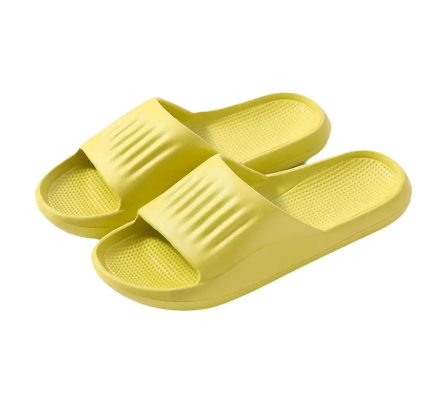Material Composition of High-Quality EVA Shoes
Understanding EVA Density and Polymer Blends
The comfort level and overall performance of good quality EVA (Ethylene Vinyl Acetate) shoes really comes down to something called EVA density. Basically, this measures how heavy the material feels for its size, and this has a big impact on both cushioning properties and how long the shoes last. When we talk about higher density materials, these tend to be tougher and offer better support, so they work great for people doing intense workouts or sports activities. On the flip side, lower density options are softer and more flexible, making them perfect for regular walking around town or casual wear throughout the day.
Most EVA shoes actually mix different types of polymers to boost how they perform when worn. This mixing changes what the EVA material can do, making it better suited for things like absorbing shocks from walking or bouncing back after being compressed. When manufacturers blend EVA with materials like rubber or TPU, which stands for thermoplastic polyurethane, the resulting shoes last longer on sidewalks and streets without getting slippery. Some top footwear companies spend serious research dollars developing these special mixes. Brands like Nike and Adidas have patent protected formulas that give their running shoes an edge over competitors in terms of both comfort and longevity.
Importance of Vinyl Acetate Content for Durability
The amount of vinyl acetate in EVA materials really makes a difference when it comes to how long shoes last and how flexible they stay. When manufacturers include more of this ingredient, the resulting material becomes less prone to cracks and maintains its shape much better during regular wear. Some research indicates that shoes made from EVA containing around 30% or more vinyl acetate tend to outlast their counterparts with lower concentrations. Walkers and runners often notice this difference after months of use, especially on rough terrain where foot support matters most. For anyone looking for footwear that stands up to daily punishment, paying attention to vinyl acetate levels can save money in the long run.
In good quality EVA shoes, the amount of vinyl acetate isn't fixed really, though most fall somewhere around 10% to 20%. This range gives the shoes both bendiness and strength without going overboard on either side. Take marathon runners for instance many of them swear by certain brands because they hold up so well even after thousands of miles. Shoe companies know this too, which is why marketing materials always mention how their products combine lasting power with comfort factors. After all, nobody wants to buy new shoes every few months just because they started falling apart at the seams.
Key Indicators of Premium EVA Footwear
Flexibility vs. Structural Integrity Tests
Getting the right mix of flexibility and structural strength matters a lot when it comes to quality EVA shoes if we want them to be both comfortable and long lasting. When testing flexibility, manufacturers look at how these shoes respond to different kinds of movement without making feet sore. At the same time, they check structural integrity to make sure all that bendiness doesn't wreck the shoe's basic shape over time. Finding this sweet spot really affects how long a pair will last before needing replacement. From what performance testing shows, good EVA shoes need enough give to let feet move naturally during activities but still hold their form after repeated wear. Most experts agree top tier footwear gets this right through careful attention to manufacturing specs and new materials entering the market, which means consumers get products that stay comfy even as they withstand daily punishment.
Shock Absorption and Energy Return Analysis
The shock absorption feature in EVA shoes plays a big role in making feet comfortable and protecting them from damage caused by repeated impacts during all sorts of activities. When shoes absorb shocks well, they actually help prevent injuries too. Studies have found that people who wear shoes with good EVA shock absorption tend to get fewer foot problems overall. Then there's this thing called energy return which basically means how much bounce back a shoe gives after hitting the ground. This matters because it helps movements feel more efficient whether someone is playing sports or just going about daily life. Not all EVA materials are created equal though. Some brands have really stepped up their game when it comes to improving these features. The research shows that exceptional shock absorption not only makes for better cushioning but also creates smoother transitions between steps. Athletes and anyone who stays active will definitely notice the difference in their shoes when this works properly.
Outsole Design and Wear Resistance Features
Rubberized EVA vs. Pure Foam Outsoles
Knowing what separates rubberized EVA from regular foam soles matters a lot when looking at how long they last and how good they stick to surfaces. Rubberized EVA tends to last longer and grip better on different kinds of ground, whether it's raining or nice and dry outside. That makes these soles great for rough terrain where people hike or play sports. On the flip side, pure foam soles are much lighter and feel softer underfoot, which many folks find comfortable. But they don't stand up so well against harsh conditions. For everyday walking around town or light exercise, though, most people prefer them. Tests done by footwear experts back this up too. They show rubberized EVA lasts longer overall and keeps feet more stable during movement compared to standard foam alternatives.
When it comes down to it, folks often pick rubberized EVA for their shoes during sports activities or when heading outdoors because they need something that lasts longer. Pure foam tends to work better for daily wear since it's lighter and more comfortable over time. Take runners who train hard on trails for example they usually go for rubberized EVA soles since these provide better traction and don't wear out as fast. Getting familiar with what different sole materials offer makes all the difference when choosing proper footwear. Whether someone needs protection against rough terrain or just wants something comfy for walking around town, knowing about these material options helps match shoes to actual needs and weather conditions.
Tread Pattern and Surface Contact Evaluation
The tread pattern on EVA shoes really affects how they stick to surfaces and keep someone stable while walking. Some patterns work better than others depending on where people wear them. For instance, deep grooves tend to bite into wet pavement much better than flat soles do. Research looking at real world accidents shows that shoes with proper tread reduce slip risks by quite a bit, which matters a lot for workers on construction sites or anyone dealing with slick floors. How the sole actually contacts different surfaces also tells us about how long the shoe will last before wearing out completely. A shoe that maintains good contact even after thousands of steps usually holds up better over time compared to ones that lose their grip quickly.
The way EVA shoes stick to surfaces matters a lot according to industry guidelines, which is why companies keep coming up with new tread patterns. These patterns help people move around better while maintaining a solid grip on different terrains. Shoe makers spend plenty of time tweaking their designs based on real world tests. Take some premium EVA models for instance they feature special treads that have gone through extensive trials across various environments, from wet sidewalks to rough trails. This attention to detail helps them stand up against normal wear and tear. When manufacturers focus on how soles interact with ground surfaces during development, they end up creating footwear suitable for everyone from weekend walkers to serious athletes who need reliable support when pushing themselves physically.
Manufacturing Signs of Superior EVA Shoes
Mold Seam Precision and Edge Smoothness
Getting mold seams right is really important when it comes to making good quality EVA shoes that last. When those seams are properly aligned, they make the shoe stronger so people don't have to replace them after just a few wears. Big name brands invest heavily in their tooling technology to get those seams looking almost invisible. What most people don't realize is how much difference smooth edges can make. A rough edge might seem small but it creates hot spots where blisters form and looks cheap too. That's why companies like Bogs spend so much time checking every single pair before shipping. They use things like laser trimmers to clean up those edges down to millimeter precision. For anyone who has ever worn poorly made shoes, they know what we're talking about here.
Consistent Foam Cell Structure Inspection
Checking the foam cell structure for consistency matters a lot when making good quality EVA shoes because this directly affects how comfortable and supportive they feel. When those foam cells are consistent throughout, we get better breathability and cushioning properties, which means people can wear them longer without discomfort and generally end up with better shoes overall. The industry has pretty strict rules about what counts as acceptable in terms of foam cell structures, showing just how important this aspect really is during production. Most manufacturers have detailed checking procedures in place so they meet these requirements, which leads to shoes that handle sweat much better and still keep feet feeling great even after extended use. Shoes with well formed foam structures tend to last longer too, plus they allow air to circulate properly and give that extra support where needed most.
FAQ
What is EVA density, and why is it important in shoe design?
EVA density refers to the weight of Ethylene Vinyl Acetate material per unit volume, influencing the shoe's cushioning and durability. Higher density often means greater durability and support, crucial for rigorous activities, while lower density can offer softness and flexibility, ideal for everyday use.
How does vinyl acetate content affect EVA shoes?
Vinyl acetate enhances the flexibility and resistance to cracking of EVA shoes, impacting their durability and longevity. High-quality EVA shoes usually have a vinyl acetate content ranging from 10% to 20%, which balances flexibility and toughness.
What are the benefits of rubberized EVA outsoles compared to pure foam outsoles?
Rubberized EVA provides enhanced durability, traction, and wear resistance, suitable for rugged environments like sports activities or hiking. In contrast, pure foam offers lightness and soft cushioning, suited for casual or less demanding activities.
Why are tread patterns significant in EVA shoes?
Tread patterns significantly influence traction and stability, supporting movement across various terrains. Well-designed patterns improve grip, preventing slips and ensuring user comfort and safety.
What is the role of mold seam precision and edge smoothness in EVA shoe quality?
Precision in mold seams ensures strength and durability, preventing wear and tear, while smooth edges enhance both comfort and aesthetic appeal, eliminating discomfort and providing a sleek look.
Table of Contents
- Material Composition of High-Quality EVA Shoes
- Key Indicators of Premium EVA Footwear
- Outsole Design and Wear Resistance Features
- Manufacturing Signs of Superior EVA Shoes
-
FAQ
- What is EVA density, and why is it important in shoe design?
- How does vinyl acetate content affect EVA shoes?
- What are the benefits of rubberized EVA outsoles compared to pure foam outsoles?
- Why are tread patterns significant in EVA shoes?
- What is the role of mold seam precision and edge smoothness in EVA shoe quality?







